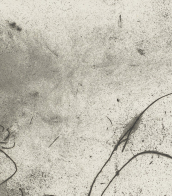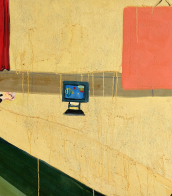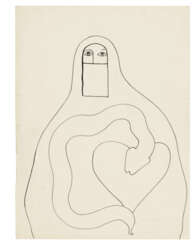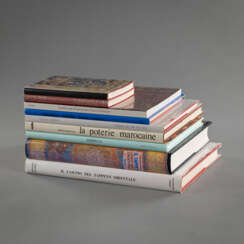marocain

David Hardy, working under the name Le Suisse Marocain (Swiss Moroccan), is an artist and gallerist who considers himself cosmopolitan.
Born in Germany, David studied at the State Academy of Fine Arts in Karlsruhe, lives mainly in Paris, but also in Sicily, Madagascar or Japan. In 1996, in the center of Paris, he set up a studio in what eventually became one of the most famous Parisian art centers called the artists' house "59Rivoli". This is where David Hardy lives and exhibits regularly. This huge studio is a hybrid of living and exhibition space and at the same time the artists' collection, the Igor Balut Museum.
David Hardy, through his work, embodies the idea of the artist as a cosmopolitan. Through sketches, copies and collages he makes the world his own. He paints everything around him, even the suitcases in which his work arrives and his clothes. Each of his works of art has its own biography, each object has its own destiny. He calls himself Roi de Rien, "King of Nothing" - a humorous and radical artist-poet who creates for the sake of creating.


David Hardy, working under the name Le Suisse Marocain (Swiss Moroccan), is an artist and gallerist who considers himself cosmopolitan.
Born in Germany, David studied at the State Academy of Fine Arts in Karlsruhe, lives mainly in Paris, but also in Sicily, Madagascar or Japan. In 1996, in the center of Paris, he set up a studio in what eventually became one of the most famous Parisian art centers called the artists' house "59Rivoli". This is where David Hardy lives and exhibits regularly. This huge studio is a hybrid of living and exhibition space and at the same time the artists' collection, the Igor Balut Museum.
David Hardy, through his work, embodies the idea of the artist as a cosmopolitan. Through sketches, copies and collages he makes the world his own. He paints everything around him, even the suitcases in which his work arrives and his clothes. Each of his works of art has its own biography, each object has its own destiny. He calls himself Roi de Rien, "King of Nothing" - a humorous and radical artist-poet who creates for the sake of creating.


Henri Matisse, a renowned French visual artist, was celebrated for his vibrant use of color and fluid, original draughtsmanship. Born on December 31, 1869, in Le Cateau-Cambrésis, France, Matisse initially pursued a career in law before turning to art. He first began painting in 1889, a change inspired by convalescence art supplies his mother provided. This marked the beginning of a journey that would see him become a leading figure in modern art.
Matisse's career is notable for its stylistic evolution yet consistent aim to capture the "essential character of things." His early works, characterized by intense colorism, earned him recognition as one of the Fauves, or "wild beasts." The period from 1908 to 1913 was marked by significant developments, with works like "Reclining Odalisque" and "The Red Studio" showcasing his mastery in balance and serenity. In the 1920s, his style evolved to more relaxed forms, with a focus on light, color, and decorative patterns in paintings like his odalisque series.
Matisse's exploration of various mediums, including sculpture and paper collage, reflects his innovative spirit. His later years were dominated by cut paper collages, as health challenges limited his ability to paint. These works, alongside his bold drawings and sculptures, cemented his status as a pioneer in visual art.
For collectors and art experts, Matisse's work remains a testament to creative evolution and expressive use of color and form. His masterpieces can be found in prominent museums and galleries worldwide, continuing to inspire and fascinate art enthusiasts.
To stay updated on new product sales and auction events related to Henri Matisse's art, sign up for our updates. This subscription will keep you informed about opportunities to appreciate and acquire works connected to this iconic artist.




Yves Henri Donat Mathieu-Saint-Laurent was a French fashion designer who, in 1962, founded his eponymous fashion label. He is regarded as being among the foremost fashion designers of the twentieth century. In 1985, Caroline Milbank wrote, "The most consistently celebrated and influential designer of the past twenty-five years, Yves Saint Laurent can be credited with both spurring the couture's rise from its 1960s ashes and with finally rendering ready-to-wear reputable." He developed his style to accommodate the changes in fashion during that period. He approached his aesthetic from a different perspective by helping women find confidence by looking both comfortable and elegant at the same time. He is also credited with having introduced the "Le Smoking" tuxedo suit for women and was known for his use of non-European cultural references and of diverse models.














































